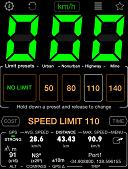 |
The Motorcycle Riders' Association of South Australia |
|
||
|
|
 |
| Speedometer Accuracy - Summary | ||||||||||||||||||||||||||||||||||||||||||
|
Australian road users should take some time to familiarise themselves with the accuracy of speedometers.
The MRASA has created this webpage to help all road users be informed. This webpage is applicable to
all road users, not just motorcyclists. Firstly you need to be aware of the changes in the Australian Design Rules (ADR). The age of your vehicle will determine which ruling you speedometer complies to. Secondly you need to be aware that regardless of what your speedometer reads, it is the road users responsibility to be within the speed limit. Radar devices are carefully calibrated and have a higher degree of accuracy, and it is that speed you will be compared against. Unless you have had your speedometer tested and know its inaccuracy, you cannot rely on it as an accurate reading. | ||||||||||||||||||||||||||||||||||||||||||
| Speedometer Variances | ||||||||||||||||||||||||||||||||||||||||||
|
Under-Read or Over-Read If a speedometer is not accurate, it could display a lower speed than the vehicle is actually travelling at, thus causing drivers to believe they are not speeding when in fact they are. This effect can occur if a speedometer under-reads true speed. Below is clarification of the terms under-read and over-read.
Apart from design criteria, several factors can affect the accuracy of speedometers. More detail is available from the Traffic Law website (link below).
Your actual speed can be easily determined these days using the Global Positioning System (GPS). Some GPS units can display speed to the first decimal place. There are numerous apps available for iPhone (or similar) that display speed using the phone's built in GPS (one pictured below). Motorists should check their speedo against a GPS device along a straight stretch of highway (we suggest you have a passenger operating the GPS device). | ||||||||||||||||||||||||||||||||||||||||||


| ||||||||||||||||||||||||||||||||||||||||||
| Australian Design Rules (ADR) | ||||||||||||||||||||||||||||||||||||||||||
|
ADRs are the guidelines used by a vehicle manufacturer to gain compliance certification but they are
not legally bound to make speedometers accurate enough to be relied upon for real vehicle speed.
The variation between pre and post 2006 models also now has no legal bearing anymore.
It is up to you to know what speed you are doing and a court does not care how you determine it.
Up until July 2006 the Australian Design Rules required new cars to have speedometers that are accurate to within 10% of actual speed. The current rules disallow under-reading, and permit over-reading by variances shown in the table below. ADR 18 - Instrumentation The function of Australian Design Rule 18 is to specify requirements for the provision of speedometers. Here is a table showing the relevant details of each revision of ADR18. | ||||||||||||||||||||||||||||||||||||||||||
| ||||||||||||||||||||||||||||||||||||||||||
|
There are specific formulas mentioned in the ADR which have been removed from the table above for
simplicity. Mopeds (UNECE vehicle category L1 and L2) mentioned in ADR18/03 have been excluded from this table.
Note that clause 5.3 of the ADR mentions a variance of 10% of actual plus 4km/h, but is further clarified in Annex 3 at
the end of the ADR as to which category of vehicle each variance refers to. If you would like to do your own research, here is a link to the ADR Online Website. Here is a link to ADR 18/03. The big change with ADR 18/03 means that the speed indicated must always be ABOVE actual speed. Prior to 1 July 2006, a speedo could read over or under the vehicle actual speed - as long as it was within 10% of the actual speed. The driver/rider can only rely on their instrument, their speedo. Owners of older vehicles (made up until July 2006) are disadvantaged. ADR 18/03 requires speedos to overestimate the actual speed of the vehicle. | ||||||||||||||||||||||||||||||||||||||||||
| A Possible Scenario | ||||||||||||||||||||||||||||||||||||||||||
Lets consider for a minute the end result of different ages of vehicles travelling down
the road sign posted as 60km/h. This segment of road will have a varied population:
Now add to that mix, those in the 3rd category driving at an indicated 5km/h under the speed limit as encouraged by the likes of the Victoria TAC i.e., the 'wipe off 5' campaign, and the differential in actual speed in a 60km/h zone could be as wide as 44km/h to 66km/h. No wonder there's road rage. The next time you get agitated by a vehicle travelling just under the limit, have some consideration, because as far as they know, they may think they are doing the speed limit. | ||||||||||||||||||||||||||||||||||||||||||
| Conclusion | ||||||||||||||||||||||||||||||||||||||||||
|
"It was pointed out to me by a solicitor that another change made in 2006 was to clarify
that the onus for a vehicle's speed is firmly on the operator, regardless of how they
determine it. The excuse of having an inaccurate speedometer is now irrelevant in law as
it is the responsibility of the vehicle operator to ensure it is accurate or that they at
all times are knowing of their velocity be it by GPS or ESP or some God given gift."
Grant Delahoy - VMC | ||||||||||||||||||||||||||||||||||||||||||
| Reference Material and Websites | ||||||||||||||||||||||||||||||||||||||||||
|
The MRASA would like to recognise the following sources and contributors of information
on the subject of speedometer accuracy. Traffic Law Website - a Victorian website with a law-centric view of speedometers. (Authority to quote and reproduce obtained from Sean Hardy, 12 March 2014) Guy Stanford, Australian Motorcycle Council (AMC) - material from the Australian Design Rules. Grant Delahoy, Victorian Motorcycle Council (VMC) Rob Salvatore, Victorian Motorcycle Council (VMC) | ||||||||||||||||||||||||||||||||||||||||||
|
| ||||||||||||||||||||||||||||||||||||||||||
|